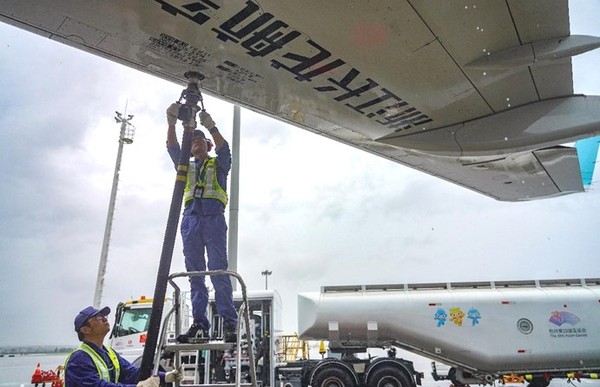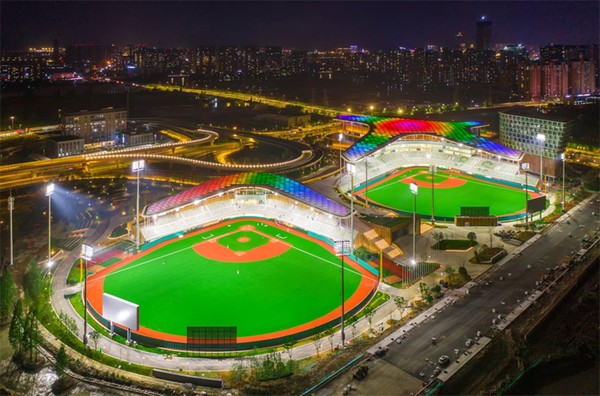By Li Zhongwen, Dou Hao, People's Daily
As evening sets in, the main stadium of the Hangzhou Olympic Sports Center, east China's Zhejiang province, shimmered under dazzling lights.
The green power traceability system displayed on a digital screen at the Zhejiang Power Exchange Center revealed the source of this luminous energy: solar and wind farms in northwest China's Qinghai province and Xinjiang Uygur autonomous region. Electricity was transmitted across a vast distance to Asian Games venues through ultra-high voltage AC/DC grids.
Zhejiang province is working to ensure green energy supply for the Hangzhou Asian Games.

A total of 94 Asian Games venues in Hangzhou traded 621 million kilowatt-hours of green electricity and 3,982 green energy certificates, which has led to a reduction in carbon dioxide emissions equivalent to approximately 76,320.9 tons of standard coal.
The State Grid Hangzhou Power Supply Company has deployed the first group of "zero-carbon" engineers in the history of the Asian Games. These engineers monitor in detail the electricity usage at each venue and utilize an intelligent platform to identify high energy-consuming equipment. Based on their findings, they propose carbon reduction plans to uncover more emission reduction possibilities for the venues.

Out of the 56 competition venues for the Hangzhou Asian Games and Asian Para Games, only 12 were newly built. The remaining 44 venues were either renovated or constructed temporarily, with many utilizing prefabricated construction methods and recyclable, renewable materials.
The design and construction of Asian Games venues and facilities followed the principle of green, low-carbon sustainability.
For instance, the Fuyang Water Sports Center, a venue for rowing and canoeing competitions, has adopted an outstanding rainwater collection and recycling system, which initially filters rainwater with pebbles and geotextile fabric on the garden floor and then transmits the water to a series of filtering facilities. The processed water is then used for fountains and irrigation at the water sports center, which helps save 35 percent of water consumption for the venue.

A new type of material is applied on the rooftop of the Shaoxing Baseball & Softball Sports Center, which is light, features excellent thermal insulation performance. It helps maintain a constant temperature inside the building and reduce the use of air conditioning.
The principle of green, low-carbon sustainability is also shown in the Hangzhou Asian Games Village - from coat hangers and cups made of wheat straw in athletes' rooms, to biodegradable tableware used in the restaurants, and to the solar systems installed on the dining hall roofs...

Sustainability is seen everywhere in the Asian Games Village - electric shuttle buses, rows of shared bikes, and wireless charging stations for electric vehicles.
All 42 competition venues located in Hangzhou have been equipped with vehicle charging facilities, with a total of nearly 800 charging poles installed.
The low-carbon transportation system of the Asian Games Village epitomizes Hangzhou's transformation towards green and low-carbon mobility. Public bicycles spread across the city's streets; electric vehicle charging poles are popping up in both old residential blocks and transportation hubs; the city's taxi fleet is steadily switching from gasoline to electric. Even a "green Asian Games" themed flight departing from the Hangzhou Xiaoshan International Airport used aviation bio-kerosine, reducing carbon emissions by over 70 percent.
With the ongoing promotion of the "Green Asian Games", green and low-carbon lifestyles are becoming a conscious action for more and more citizens.
At an Asian Games franchised store in downtown Hangzhou, many local residents and tourists were shopping for "zero-carbon mascots," such as backpack made from 10 recycled beverage bottles, frisbee made from 1,000 grams of rice husks, and recyclable sofa stool made from negative carbon materials...Each purchase of a low-carbon mascot contributes to carbon reduction.
Alipay, a third-party mobile and online payment platform launched by Chinese e-commerce giant Alibaba, is encouraging users to gain energy points by participating in over 60 low-carbon activities, such as joining green transportation, using online public services, and setting air conditioners to appropriate temperatures. So far, more than 100 million people in China have participated in these activities.
More people are enjoying the convenience brought by the green Asian Games. "With the Asian Games approaching, Hangzhou is building more urban greenways. I'm used to biking to work now," said a local resident Zhao Wenzhe. Hangzhou is home to 16.2 kilometers of riverside greenways, which integrate leisure, sightseeing and entertainment into a slow traffic system.
Statistics show that Hangzhou has built eight types of greenways totaling over 4,700 kilometers, allowing citizens to reach a greenway within five minutes' walk.
From proposing the "Green Asian Games" concept, to implementing green actions, and to the widespread societal participation, hosting the Asian Games has driven China to advance coordinated urban development and environmental protection, and to better promote low-carbon production and lifestyles.

